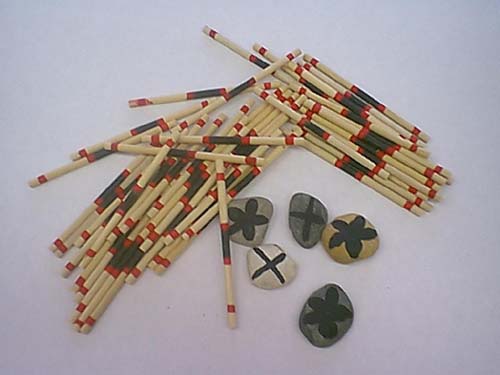| Origin: | Arapaho of Oklahoma | ||||||||||||||||
| History: | This game was played by many nations and called by many names. Usually nations would compete against one another and set wagers on the game. These games provoked great celebrations and people would cheer "hub hub hub..." hence the name "hubbub" began to emerge. | ||||||||||||||||
| Original Materials: | Bone or plum pits - dice; counting sticks | ||||||||||||||||
| Adapted Materials: | 5 stones or bottle caps; 50 popsicle sticks or toothpicks - counters; basket | ||||||||||||||||
| Players: | 2 players or teams | ||||||||||||||||
| Setup: | Decorate 1 side of the dice; make 3 alike (stars) and 2 different (x's). | ||||||||||||||||
| To Play: | Take turns tossing the dice that are thrown and collecting the corresponding point values. The game ends when all 50 of the counters are gone. | ||||||||||||||||
| To Score: | There are 2 x's and 3 star pattern on the dice used. Certain patterns correspond to point values. The object is to get the most counting sticks.
| ||||||||||||||||
| Variations: | The Bowl & Dice (see game #5) game is a more difficult version of this game. | ||||||||||||||||
| Math Content: | Probability, patterns and relations, data management | ||||||||||||||||
| Source: | Carlson L. (1994). More Than Moccasins, Chicago Il: Chicago Review Press. | ||||||||||||||||
 |
 Return to Aboriginal Games | Return to Math Central |